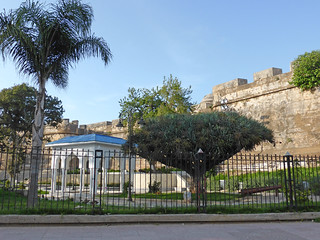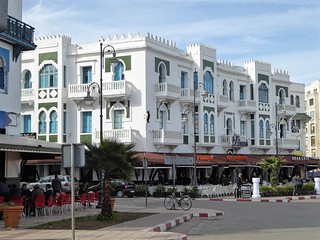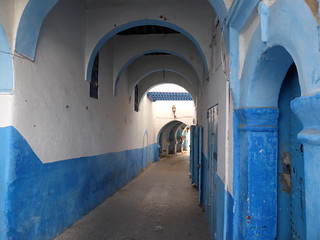Larache (also known as ‘El Araich’) is an important harbour town (with apparently a thriving fishing industry) and is located on the Atlantic north coast of Morocco. It was founded in the 7th century when a group of Muslim soldiers from Arabia extended their camp at ‘Lixus’ on the south bank of the ‘Loukkous’ river. The town was probably founded by the ‘Banu Arous tribe’, who gave it the name ‘Araich Beni Arous’.

Picture (with kind permission): Miguel
North of the river Loukos, four to five kilometers outside of Larache, are the Roman remains of Lixus. It was settled by the Phoenicians in the 7th century BC. Lixus was part of a chain of Phoenician / Carthaginian settlements. After the destruction of Carthage, Lixus fell to Amazigh (Berber) and was under control by king Juba II in 1180 BC. Other major settlements further to the south are ‘Chellah’ and ‘Mogador’. When Carthage fell to Ancient Rome, Lixus, Chellah and Mogador were annexed to the Kingdom of Mauretania. Some ancient Greek writers located at Lixus the mythological garden of the Hesperides, the keepers of the golden apples. However, these ruins are not as impressive as the ones in ‘Volubilis’.

Picture (with kind permission): Miguel
In 1489, a few kilometres inland from Larache at the junction of river ‘Lucus’ (Wadi Lukkus) and river ‘el-Mekhazen’ (Oued Makhazine), the Portuguese established the ‘Graciosa’ fortress. The fortress was built from February 1489 by ‘Gaspar Jusarte’. The Portuguese did not resist long in ‘Graciosa’. Larache’s ancient medina was built during the 15th century. In 1491, the Portuguese built a Kasbah (Qebibat – a fortress), which is now in a state of serious disrepair.

Picture (with kind permission): Miguel
The walls that surrounded the medina and the Kasbah (now in ruins) are very much the old part of the city which contains condensed housing and narrow lanes and steps. The main gate is ‘Bab al-Kehmis’ but there are several other gates as well. In 1610, the town passed to the Spanish, who stayed there until 1689. In the 17th century, the Spanish built a fortress known as the ‘Casbah de la Cigogne’, during their first occupation.

Picture (with kind permission): Miguel
Periods of Berber, Arab, and Spanish rule have left their mark, although the most dominant is the Muslim influence. The layout of the old town is typically Moorish, while houses in the new town seem to be in ‘Andalusian’ style and still reveal the strength of the Spanish influence.

Picture (with kind permission): Miguel
The new town is a good example of Spanish colonial architecture. The colours of the buildings are a beautiful white-washed white and blue. Although the town has seen better days, it still has a nice atmosphere. It became the main port of the Spanish protectorate in 1911 and held it for 45 years until 1956.

Picture (with kind permission): Miguel
Today, Larache has a population of approximately 125,008 and draws its livelihood from agro-food industry and fishing, although it has lost its status as a major port. The more traditional handcrafts of Morocco are found in the medina.

Picture (with kind permission): Miguel
Larache, like the other towns on this stretch of coast, is sleepy and laid-back for most of the year, bursting into life in summer when Moroccan tourists come to the beach. The charming town otherwise sees few visitors.

Picture (with kind permission): Miguel
Larache is part of the tourism region ‘Cap Nord‘ of Morocco.
